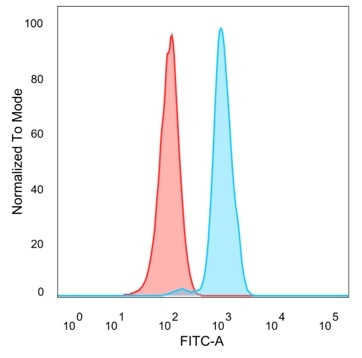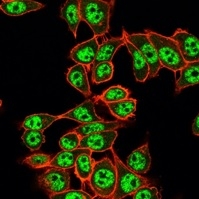Learn about our comprehensive antibody validation methods to ensure monospecificity. Antibody Validation>>

Flow Cytometric Analysis of PFA-fixed HeLa cells. Y14 / RBM8A Mouse Monoclonal Antibody (PCRP-RBM8A-1B4) followed by goat anti-mouse IgG-CF488 (blue); unstained cells (red).

Immunofluorescence Analysis of PFA-fixed HeLa cells using Y14 / RBM8A Mouse Monoclonal Antibody (PCRP-RBM8A-1B4) followed by goat anti-mouse IgG-CF488 (green). CF640A phalloidin (red).

Analysis of Protein Array containing more than 19,000 full-length human proteins using Y14 / RBM8A Mouse Monoclonal Antibody (PCRP-RBM8A-1B4). Z- and S- Score: The Z-score represents the strength of a signal that a monoclonal antibody (MAb) (in combination with a fluorescently-tagged anti-IgG secondary antibody) produces when binding to a particular protein on the HuProtTM array. Z-scores are described in units of standard deviations (SD's) above the mean value of all signals generated on that array. If targets on HuProtTM are arranged in descending order of the Z-score, the S-score is the difference (also in units of SD's) between the Z-score. S-score therefore represents the relative target specificity of a MAb to its intended target. A MAb is considered to specific to its intended target, if the MAb has an S-score of at least 2.5. For example, if a MAb binds to protein X with a Z-score of 43 and to protein Y with a Z-score of 14, then the S-score for the binding of that MAb to protein X is equal to 29.
Y14 Antibody is a high quality monoclonal Y14 antibody (also designated Y14 antibody) suitable for the detection of the Y14 protein of mouse, rat, human and Xenopus laevis origin. Y14 Antibody (4C4) is available as both the non-conjugated anti-Y14 antibody form, as well as multiple conjugated forms of anti-Y14 antibody, including agarose, HRP, PE, FITC and multiple Alexa Fluor conjugates. The exon junction complex (EJC) is a multiprotein complex that assembles approximately 20-24 nucleotides upstream of exon-exon junctions in pre-mRNAs. It is involved in mRNA export, cytoplasmic localization, and nonsense-mediated mRNA decay. Members of the EJC include Y14, Aly/REF, Magoh, RNPS1, SRm160, and DEK. Aly/REF, Magoh, and Y14, identified as RBM8 in mouse and rat, make up the core of the EJC, and these proteins remain stably bound to spliced mRNAs in the cytoplasm until they are translated. Therefore, Y14, Aly/REF, and Magoh have the ability to communicate to the cytoplasm the processing history of the mRNA, including the position of the removed introns. The gene encoding human Y14 encodes three transcripts. Y14 is a ubiquitously expressed protein. Although Y14 shuttles to the cytoplasm, it is predominantly detected in the nucleus and is co-localized with oskar mRNA at the posterior pole of the cell.
There are no reviews yet.